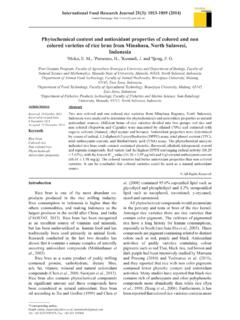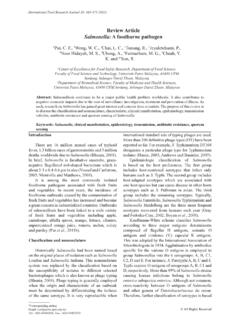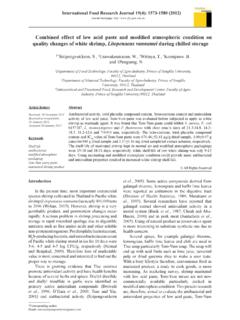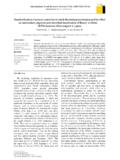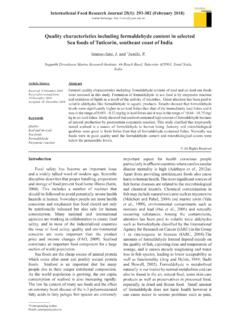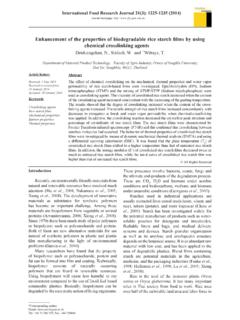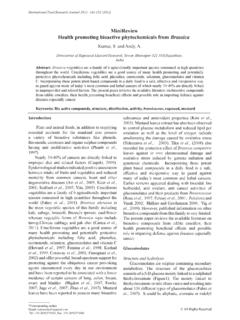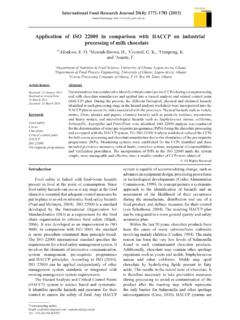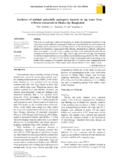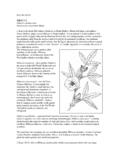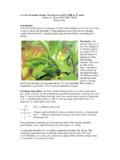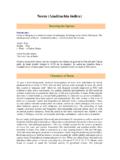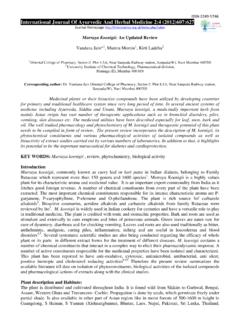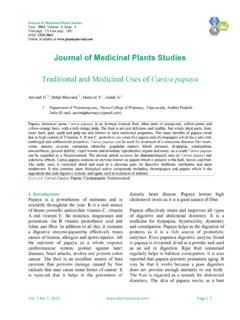Transcription of Investigations into the antibacterial activity of Ziziphus ...
1 International Food Research Journal 22(2): 849-853 (2015). Journal homepage: Investigations into the antibacterial activity of Ziziphus mauritiana Lam. and Ziziphus xylopyra (Retz.) Willd. Sameera, N. S. and *Mandakini, B. P. University Department of Biochemistry, Rashtrasant Tukdoji Maharaj Nagpur University, Nagpur-440033, Maharashtra, India Article history Abstract Received: 9 June 2013 Ziziphus plants (Rhamnaceae family) are reported to possess bioactive compounds, recognized Received in revised form: for traditional use and medicinal importance. Present work aims to evaluate antibacterial 21 November 2014 activity of stem extracts of Ziziphus mauritiana Lam. and Ziziphus xylopyra (Retz.) Willd. Accepted: 28 November 2014. Stem barks were extracted in different solvents and analyzed by agar well diffusion assay. Z. mauritiana methanol extract (ZMM-A) had greatest antibacterial activity against S.
2 Aureus (22. Keywords mm) which was identical to positive control Gentamycin (22 mm), while the Gram negative test Ziziphus mauritiana organisms were resistant to Z. xylopyra aqueous-dioxane extract (ZXAD). Minimum inhibitory Ziziphus xylopyra concentration (MIC) to suppress most sensitive S. aureus exemplified ZMM-A extract at antibacterial activity mg/ml and Z. xylopyra methanol extract (ZXM-A) at mg/ml. Gas Chromatography Mass Spectrometry (GC-MS) study of potent ZMM-A and ZXM-A extracts reflected presence of variety of compounds responsible for antibacterial activity and require further intensive study. This research finding signifies methanolic Ziziphus stem bark extracts as possible and reliable natural source of pharmaceutical drug with antibacterial potential. All Rights Reserved Introduction Goyal et al., 2012). Screening of plant extracts for antimicrobial activity has demonstrated that higher A major disaster for the mortality and morbidity plants epitomize a potential source of novel antibiotic amongst humans and animals are infectious diseases.
3 Prototypes. Antimicrobial activity of some members Emergence of multi-drug resistance, existing anti- of genus Ziziphus has already been reported in the microbials with undesirable effects and restricted literature (Abalaka et al., 2010; Ahmad et al., 2011;. anti-microbial spectrum creates further annoyance Dangoggo et al., 2012; Dhunmati et al., 2013). diverting attention towards natural antimicrobials For instance, the seed extract of Z. mauritiana was (Ngoci et al., 2014). Traditionally from prehistoric stated to demonstrate antiplasmodial effects (Mishra times, the use of different parts of medicinal plants and Bhatia, 2014). Further, the fruit extract of Z. was practiced to cure specific ailments evidently rugosa Lam. was determined to undertake cytotoxic, due to presence of some bioactive compounds like antibacterial and free radical scavenging activity alkaloids, flavonoids, essential oil, glycosides, (Hossain et al.)
4 , 2013). Present study was aimed to tannins, terpenoids, steroids and others. Many of the investigate the antibacterial potential of different drugs, currently in use have been isolated from natural solvent extracts of the barks of Z. mauritiana and Z. sources based on information about curative agent xylopyra for its ethnomedical use in the treatment of in folklore medicine. United States Food and Drug infectious diseases. Administration (FDA) have approved unmodified natural products or partly-synthetic drugs derived Materials and Methods from natural source for 78% of new drugs between 1983 and 1994 (Sharmin et al., 2014; Ngoci et al., Authentication of plant materials 2014). Ziziphus mauritiana Lam. and Ziziphus xylopyra Ziziphus species comprises about 40 species (Retz.) identified through ethnobotanical distributed in warm-temperate and subtropical approach by the taxonomist of Department of Botany, regions.
5 Ziziphus plants are traditionally used as RTM Nagpur University, Nagpur, Maharashtra, India. medicine for the treatment of various diseases such A sample specimen was conserved with the voucher as digestive disorders, urinary troubles, diabetes, number as RTMNU BD 9138 and 9139, respectively. skin infections, diarrhea, fever, bronchitis, liver complaints, anaemia, etc. (Mishra and Bhatia, 2014;. *Corresponding author. Email: 850 Sameera, N. S. and Mandakini, 22(2): 849-853. Preparation of extract Test isolates Bioactive compounds from the bark of above antibacterial activity of Z. mauritiana and Z. referred species were processed using different xylopyra extracts was determined against Gram solvent (Fig 1) to isolate various extracts. positive microorganisms using Bacillus megatherium (NCIM 2087), Bacillus subtilis (NCIM 2479), Klebsiella aerogenes (NCIM 2239), Staphylococcus aureus (NCIM 2079) and Gram negative microorganisms as Escherichia coli (NCIM2572), Proteus vulgaris (NCIM 2027), procured from National Collection of Industrial Microorganisms, Pune (India).)
6 Determination of antimicrobial activity Agar well bioassay and even disc diffusion assay was performed to investigate antibacterial activity of Z. mauritiana and Z. xylopyra extracts, as mentioned by Berghe with slight modification (Berghe and Vlietinck, 1991; McFarland, 1907). Filter sterilized samples solubilized in dimethylsulphoxide (DMSO, Crude solvent extracts as DCM Dichloromethane, EA Ethyl ) were loaded onto the test strain seeded in acetate, MA methanol, MB methanol containing ascorbic acid, AD aqueous-dioxane Mueller Hinton II agar plates and incubated at 37 C. Figure 1. Outlines of extraction procedure followed for 24 h with DMSO ( ) as negative control for different Ziziphus species extract. Solvent extracts and standard antibiotic amoxycillin and gentamycin of DCM- dichloromethane, M-A- methanol, EA- ethyl as positive control. antibacterial activity was acetate, M-B- methanol containing ascorbic acid, AD- determined by measuring the diameter of the zone of aqueous-dioxane inhibition.
7 Experiments were performed in triplicate. A method directing acid-base treatment was followed Determination of Minimum Inhibitory Concentration to achieve ethyl acetate solvent extract of Z. mauritiana (MIC). (ZMEA) and Z. xylopyra (ZXEA) as mentioned MIC was determined for Ziziphus extracts by Cordeiro et al. (1999). Another procedure track showing efficacy with the sensitive bacterial isolates successive soxhlet extraction as cited by Uddin et by a modified agar well diffusion technique (Okeke al. (2003) to with ethyl acetate, concluding to get et al., 2001). A dilution of extracts with a decreasing methanol solvent extract of Z. mauritiana (ZMM-A) concentration range from 10 to 1 mg/ml in DMSO was and Z. xylopyra (ZXM-A). Isolates were obtained loaded onto Mueller Hinton Agar plates seeded with as brownish crude residue with dichloromethane test bacterial cells for least concentration of extract solvent extract of Z.
8 Mauritiana (ZMDCM) and showing a clear zone of inhibition, in triplicate. Z. xylopyra (ZXDCM), as revealed by Perez et al. (2004). Extraction method (Hagerman, 2002) started Gas chromatography Mass spectrometry with ethanol containing ascorbic acid (10 mM) at A Varian 4500 GC coupled with Varian MS240 ion low temperature followed by methanol containing trap mass spectrometer (Varian, Walnut Creek, USA). ascorbic acid (10 mM) as solvent extract of Z. was employed for the determination of analytes using mauritiana (ZMM-B) and Z. xylopyra (ZXM-B). A electron ionization (EI) mode. Split less injections of solvent mixture of dioxane-water (96:4, v/v) was also 1 l volume were carried out with a split promable pursued to isolate aqueous-dioxane solvent extract of temperature injection (STI) Type 1079 kept at 270 C. Z. mauritiana (ZMAD) and Z. xylopyra (ZXAD), by The Ion trap, manifold and the transfer line were kept the method of Ramasamy (1982).
9 At 240, 40 and 250 C, respectively. Separations were performed on Varian Chrompack Capillary column Phytochemical screening WCOT Fused Silica (30 m long, mm ID) CP-Sil Phytochemical screening of Z. mauritiana and 8CB, helium (Ultra pure ) was employed as Z. xylopyra extracts was performed by standard a carrier gas. Compounds were identified by direct methods (Harborne, 1973; Trease and Evans, 1978). comparison of their MS (Mass Spectrum) with data from the NIST library. Sameera, N. S. and Mandakini, 22(2): 849-853 851. Table 1. antibacterial activity of different Ziziphus mauritiana extracts evaluated against the test organisms The diameters of zone of inhibition (mm) are expressed as mean (n=3). Solvent extracts of ZM- Z. mauritiana as DCM- dichloromethane, M-A- methanol, EA- ethyl acetate, M-B- methanol containing ascorbic acid, AD- aqueous- dioxane Table 2. antibacterial activity of different Ziziphus xylopyra extracts evaluated against the test organisms The diameters of zone of inhibition (mm) are expressed as mean (n=3).
10 Solvent extracts of ZX- Z. xylopyra as DCM- dichloromethane, M-A- methanol, EA- ethyl acetate, M-B- methanol containing ascorbic acid, AD- aqueous-dioxane Results between the potential of actual bioactive compounds involved and a synergistic outcome of the extracts. Phytochemical analysis revealed existence of GC-MS performed for the most potent ZMM-A. alkaloids, flavonoids, triterpenoids and tannins in the illustrated presence of compounds as 2H-1-Benzopyran- bark extract of Z. mauritiana Lam. and Z. xylopyra 2-one, 9,10-Anthracenedione, 4H-1-Benzopyran-4-one, (Retz.) Willd. Investigation showed that almost all 2-(3,4-dihydroxyphenyl)-5-hydroxy-3,7-di methoxy-, the Ziziphus bark extracts retain significantly diverse 3,4-Dihydroisoquinolin-7-ol,stigmasterol ,Olean-12- ene-3 ,15 ,16 ,21 ,22 ,28-hexol,-methoxy-3,3- antibacterial activity against the test organisms dimethyl-1-methylsulfanyl-,Stigmastane-3 ,6-dione, compared to standard antibiotics (Table 1 and 2) with (5 )-,Olean-12-ene-3 ,15 ,16 ,21 ,22 ,28-hexol, significant activity towards Gram positive bacteria 4H-1-Benzopyran-4-one,2-(3,4-dihydroxyph enyl)-7- than the Gram negative test strains.
